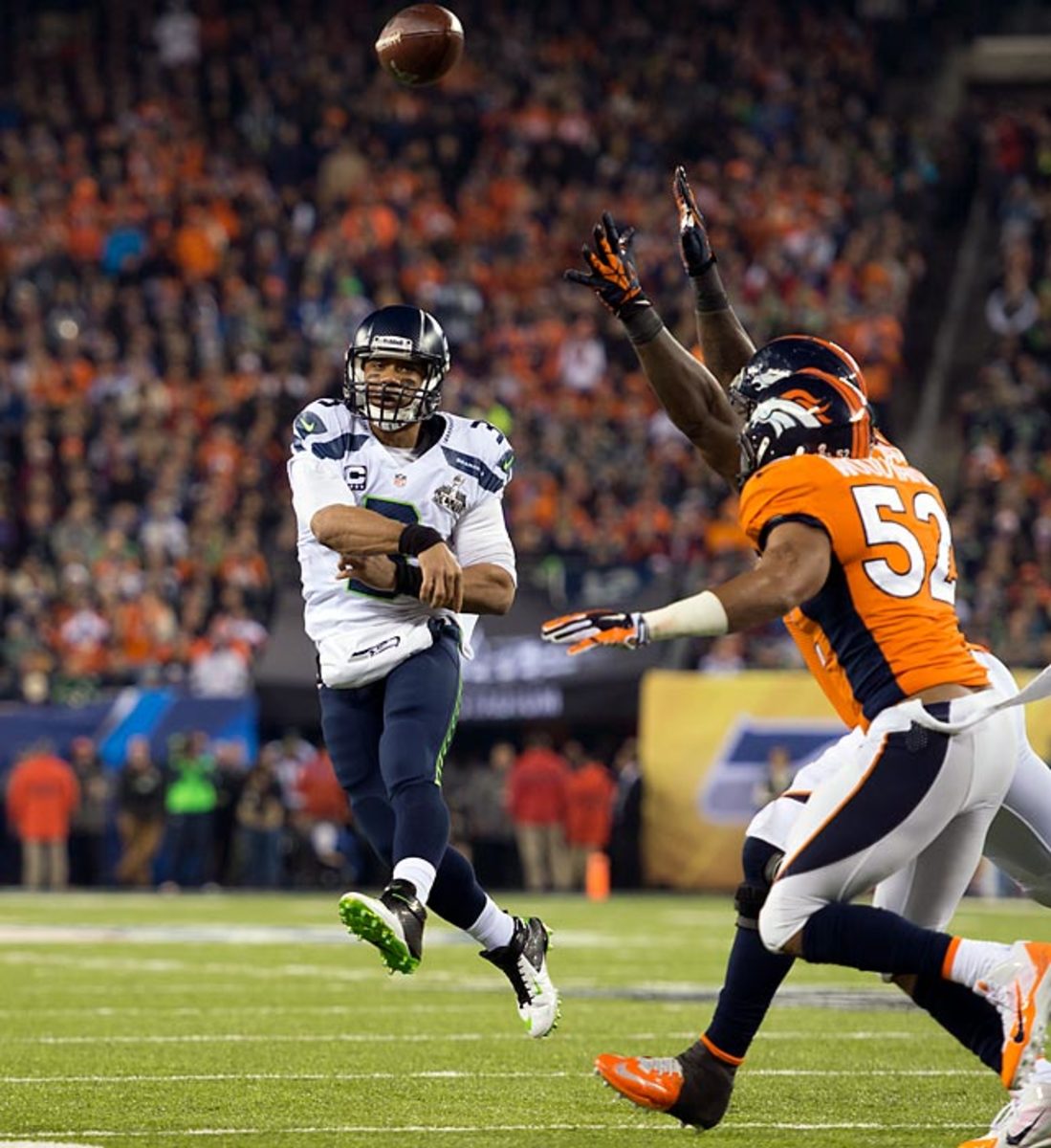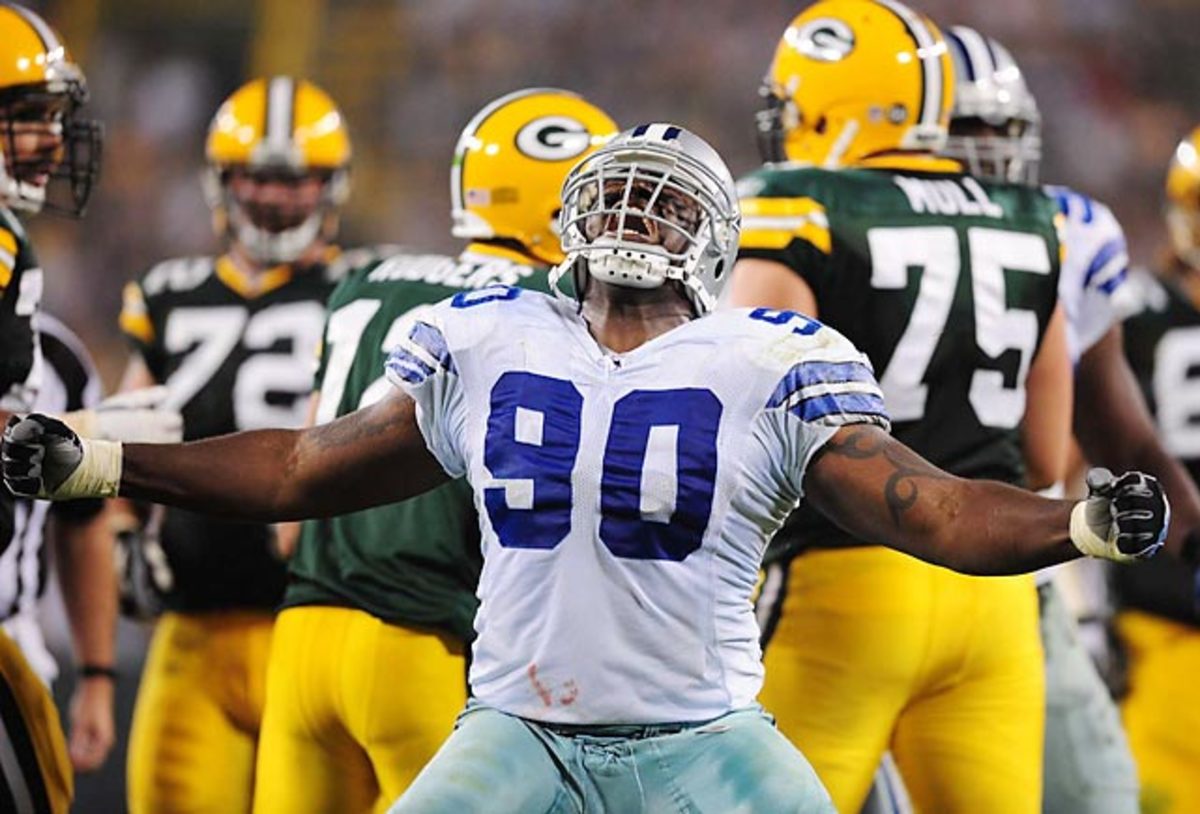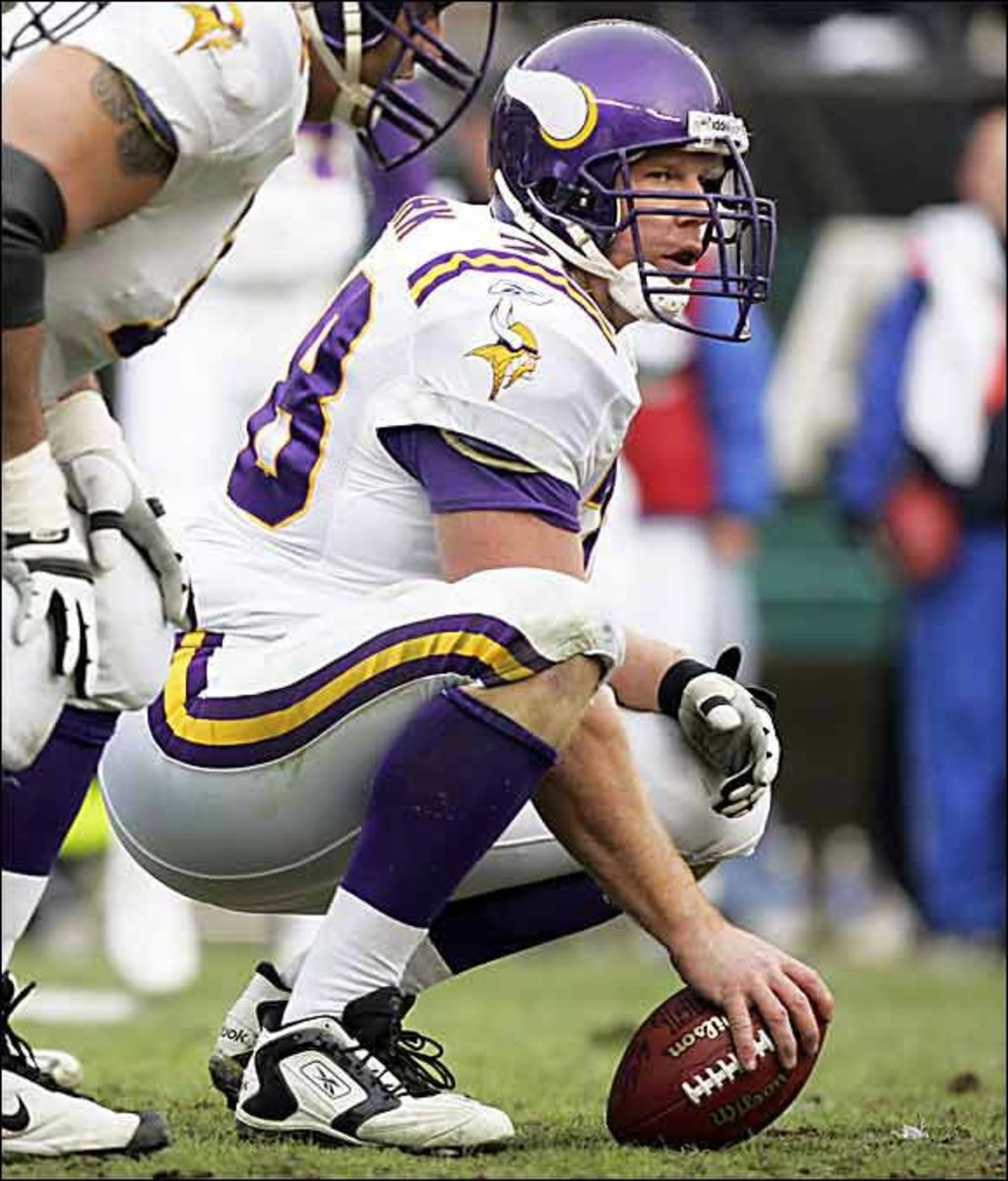Best Draft Bargains of Past 25 Years

Best Draft Bargains of Past 25 Years
Russell Wilson

Standing 5-foot-11 in the pocket, Russell Wilson had doubters. Evaluators knew he had talent, but his height slipped him to Seattle in the third round. It was conceivably a steal -- but nobody could have predicted that he'd earn the starting job as a rookie, play in the Pro Bowl as an alternate, and a year later pilot the Seahawks to a Super Bowl win. After just two seasons, he sure doesn't look like the 6th best quarterback in his draft class.
Richard Sherman

The Seahawks hit the jackpot with this pick, despite the on-field controversies in which Richard Sherman has been involved. In the 2013 regular season, the fifth-round pick out of Stanford in 2011, was targeted 58 times on 549 defensive snaps, which was a league-low 10.56 percent among qualifying cornerbacks. And he still led the NFL with eight interceptions. In two playoff games before the Super Bowl, he was targeted twice -- yes, two times in two games -- with no catches against him. Then he and the Legion of Boom defense totally dominated Peyton Manning and Denver in a resounding 43-8 Super Bowl victory.<italics> </italics>
Greg Hardy

The Carolina Panthers led the NFL with 60 sacks in 2013 and one of the big reasons was Greg Hardy, a sixth-round gem out of Ole Miss from the 2010 draft. The four-year veteran had 15 of those sacks, which tied a franchise record set by Kevin Greene in 1996. In making his first Pro Bowl, Hardy led the Panthers with 38 quarterback pressures and made a career-high 67 tackles for the NFC South champions.
Kam Chancellor

A strong safety who looks like he should be playing linebacker and the hardest hitter in the best secondary in the NFL, Kam Chancellor came to Seattle from Virginia Tech by way of a fifth-round pick in 2010. The Seahawks thought so much of him after their Super Bowl XLVIII victory (nine tackles, one interception) that they signed him to a five-year extension worth up to $34 million.
Stevie Johnson

Though his end zone behavior and Twitter activity have drawn their share of scrutiny, Steve Johnson was a find for Buffalo in the seventh round out of Kentucky. He earned a starting position two seasons later and enjoyed a breakout season in 2010, making 82 catches for 1,073 yards and 10 touchdowns, the first in a string of three straight 1,000-yard campaigns.
Marques Colston

Even the Saints weren't sure how good Colston was when they drafted the big receiver out of Hofstra. But the the 6-foot-4, 231-pound Colston proved very difficult to cover in his rookie season. He caught 70 passes for 1,038 yards despite missing several games with an ankle injury. At the end of the 2013 season he was the team's all-time leader in receiving yards, yards from scrimmage, receiving touchdowns, total touchdowns and total receptions.
Kyle Williams

Despite a successful college career at LSU, Kyle Williams waited until the fifth round of the 2006 draft to hear his name called as teams questioned his build and athleticism. He became a starter his rookie season with the Bills and went on to make three Pro Bowls and two All-Pro teams.
Jay Ratliff

Due to questions about his size, Auburn's Jay Ratliff fell into the seventh round in 2005, where he was selected by Dallas. He quickly became part of the defensive line rotation and made his first of four Pro Bowls as a Cowboy in 2008 with 51 tackles and 7.5 sacks at nose tackle.
Robert Mathis

One of only three players to make the NFL after attending Alabama A&M, Robert Mathis has made an indelible mark. On Dec. 15, 2013, he set both a franchise sacks record (108) and the Colts' single-season record (16½). He would go on to finish with a league-best 19½, earning the league's first Deacon Jones Award, named after the late Hall of Fame defender who is credited with leading to the creation of the term sack.
Steve Smith

Teams avoided the Utah product because he's only 5-foot-9, 185 pounds. But he made an instant splash for the Panthers, earning a trip to the Pro Bowl as a rookie because of his outstanding punt- and kick-return skills. Then Smith developed into a dominant receiver. In 2005, he had 103 catches for 1,563 yards and 12 touchdowns. At the end of the 2013 season he was Carolina's all-time leader in total touchdowns (69), receptions (800, and receiving yards (11,785), and he led all active players in all-purpose yardage.
Tom Brady

After Brady shared starting duties at Michigan with Drew Henson, most scouts didn't believe he had the physical tools to be a starting NFL quarterback. He was too thin, ran a slow 40 at the combine and didn't have a strong enough arm. The Patriots saw some upside, but even they had to be surprised at how successful Brady was after taking over for an injured Drew Bledsoe in 2001. Brady became the first QB to start and win three Super Bowls before age 28.
Adalius Thomas

A sixth-round selection out of Southern Mississippi, Thomas gradually worked his way into playing time with Baltimore, making the Pro Bowl as a special-teamer in 2003. He became a starter in 2004 and made the Pro Bowl again in 2006 with 106 tackles and 11 sacks as a lynchpin of the league's top defense.
Kabeer Gbaja-Biamila

Gbaja-Biamila entered college weighing less than 200 pounds but set the career sack record at San Diego State with 33. Measuring 6-foot-3½, 245 pounds at the combine, he was considered too small to play on the defensive line. But the Packers were confident he could put on weight and play defensive end. They were right, and Gbaja-Biamila quickly became one of the league's top pass-rushers.
Donald Driver

Drafted out of Alcorn State in the seventh round in 1999, Driver became one of the most popular and prolific Packers. He had six straight 1,000-yard seasons from 2004-09, averaging 14 yards per catch during the stretch. He made at least one catch in 133 straight games from 2002 to 2010, another franchise record. He finished his 14-year career as Green Bay's all-time leader in yards receiving (10,137 yards), catches (743) and 1,000-yard seasons (seven), and was third behind Don Hutson and Sterling Sharpe with 61 touchdown receptions. A four-time Pro Bowl pick, he was Green Bay's MVP in 2002 and was part of the team that won the Super Bowl following the 2010 season.
Hines Ward

An all-purpose athlete at Georgia, Ward played quarterback, running back and receiver for the Bulldogs, but after joining the Steelers he shifted solely to receiver and was an outstanding one. He was named MVP of Super Bowl XL.
Matt Birk

An All-Ivy performer at Harvard, Birk was a fixture at center for the Vikings from 2000 to 2008 and won a Super Bowl ring as the Baltimore Ravens center in the 2012 season. He earned his first of six Pro Bowl bids in 2000.
Terrell Owens

Owens was a late bloomer in football, not starting in high school until his senior year. He was lucky to be recruited by Tennessee-Chattanooga, where he split his time with the basketball team. Although T.O.'s size and speed were evident, NFL teams didn't know what to make of his small-school background. The 49ers were looking for an heir apparent to Jerry Rice and hit the jackpot with Owens. He had his fair share of off-field issues, but was great on the field for the Niners, Eagles and Cowboys.
Tedy Bruschi

Bruschi tied the NCAA Division I-A sack record as a defensive lineman in Arizona's "Desert Swarm" defense, but he was too small to play lineman in the NFL and many thought he was too slow to play linebacker. The Patriots have developed a keen eye for the intangibles that made Bruschi such an effective linebacker. He was the emotional leader of a defense that led the Patriots to three Super Bowl championships.
Zach Thomas

A classic example of why combine results aren't everything when it comes to drafting quality players: Thomas was a standout at Texas Tech, but scouts considered him too small and slow. But those who saw him on a weekly basis in college knew Thomas made up for his shortcomings with tenacity and outstanding instincts. When he arrived in Miami, he instantly became the leader of the defense. A seven-time Pro Bowl pick and five-time First-Team All-Pro, Thomas racked up more than 1,100 tackles over a 13-year career spent mostly with the Dolphins.
Stephen Davis

Davis didn't get a chance to work out at the combine because of a knee injury, which explains how he fell to the fourth round. His breakout season came in 1999, when he led the NFC with 1,045 yards. In 2001 he set Washington's single-season record for rushing yards (1,432). Davis went to Carolina in '03, set a personal-best mark with 1,444 yards rushing and helped the Panthers reach the Super Bowl.
Curtis Martin

Martin was voted preseason All-America his senior year at Pitt, but an injury in the second game forced him to sit out the rest of the season. As a rookie he started 14 games, finishing with franchise records for carries (368), yards (1,487) and rushing touchdowns (14). He played three seasons with the Patriots before moving on to the Jets. He retired as the fourth-leading rusher in NFL history.
Terrell Davis

After a lackluster college career in which he transferred from Long Beach State to Georgia and missed most of his senior year with a hamstring injury, Davis fell to the sixth round. But he earned a starting spot in Denver his rookie season and provided the answer at running back the Broncos desperately needed. Davis helped the Broncos win the Super Bowl in 1997 and '98 and became the fourth running back to reach 2,000 yards in a season in '98.
Rodney Harrison

After playing at Western Illinois, Harrison broke in as a special-teams player and then became a star safety. He was named the Chargers' defensive player of the year in 1996 and '97 and was a Pro Bowler in '98. In 2003 he joined the Patriots and became a leader on a defense that helped New England win back-to-back Super Bowls. Harrison had a reputation for nasty hits but was respected for his nonstop motor and outstanding instincts.
Jamal Anderson

Anderson was not well known when he was selected by the Falcons. The '98 season, though, was special -- he ran for 1,846 yards and helped Atlanta reach Super Bowl XXXIII. The former Utah star used his anger at falling to the 201st pick as a motivating factor throughout his career.
Keenan McCardell

Even though McCardell left UNLV as the school's all-time leading receiver, NFL teams weren't interested in the 6-foot-1 wideout. The Redskins picked him up late, which was fortunate for McCardell, who learned from Art Monk and Gary Clark. After bouncing around the league, McCardell landed in Jacksonville and became one of the NFL's most consistent No. 2 receivers. In 2002, McCardell caught two TDs to lead the Bucs to a Super Bowl championship.
Leon Lett

Out of tiny Emporia State, Lett burst into the Cowboys' starting lineup in 1994 and made the first of his two Pro Bowl appearances that season. One of the most dominant defensive tackles of his time, Lett was a member of three Cowboys Super Bowl championship teams, starting in Super Bowls XXVIII and XXX. Lett's off-the-field indiscretions and questionable plays sometimes tarnished his image, but he was a force during his 11-year career.
Shannon Sharpe

Seven tight ends were selected before Sharpe in 1990, but no player at that position ever achieved as much as Sharpe did in his 14-year career. He retired as the all-time leader in receptions (815), yards (10,060) and TDs (62) for a tight end (all threee since surpassed by Tony Gonzalez) and won three Super Bowl rings with the Broncos and Ravens. Not bad for a player who was barely recruited out of high school, played at small Division I-AA Savannah State and was almost cut by the Broncos early in his career.
Thurman Thomas

Thanks to a serious knee injury he suffered at Oklahoma State, Thomas slipped to the Bills in the second round. He energized Buffalo's offense and helped form a nucleus that carried the Bills to four straight Super Bowls. He retired in 2001, ranking sixth all time in total yards from scrimmage (16,532) and ninth in rushing (12,074). Thomas said the anger he felt at being bypassed in the first round was a motivating factor in his rise to stardom.
